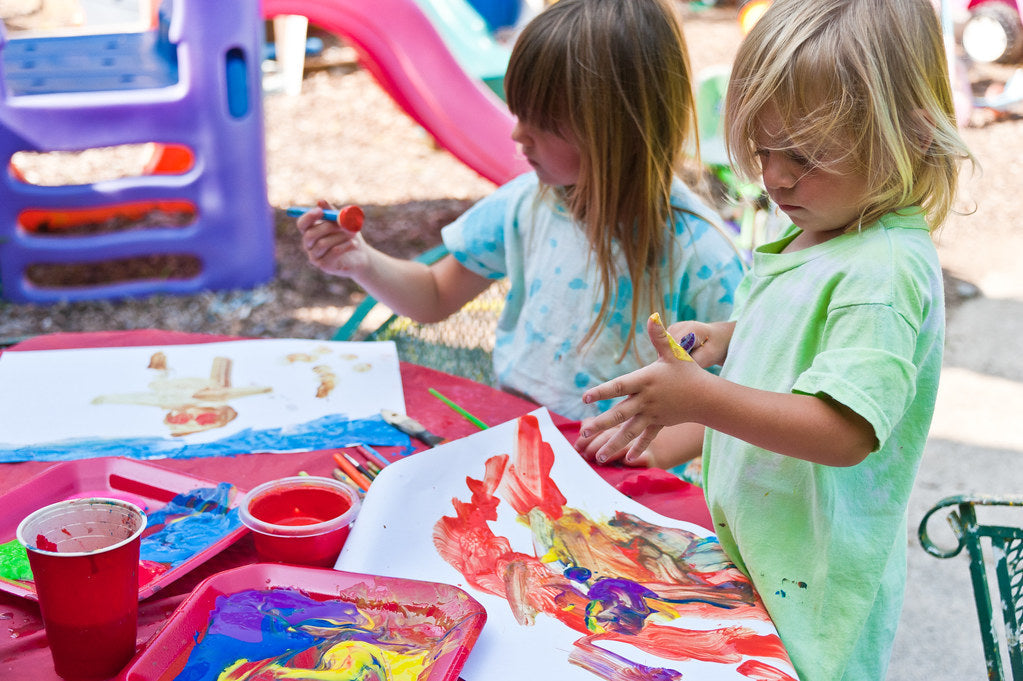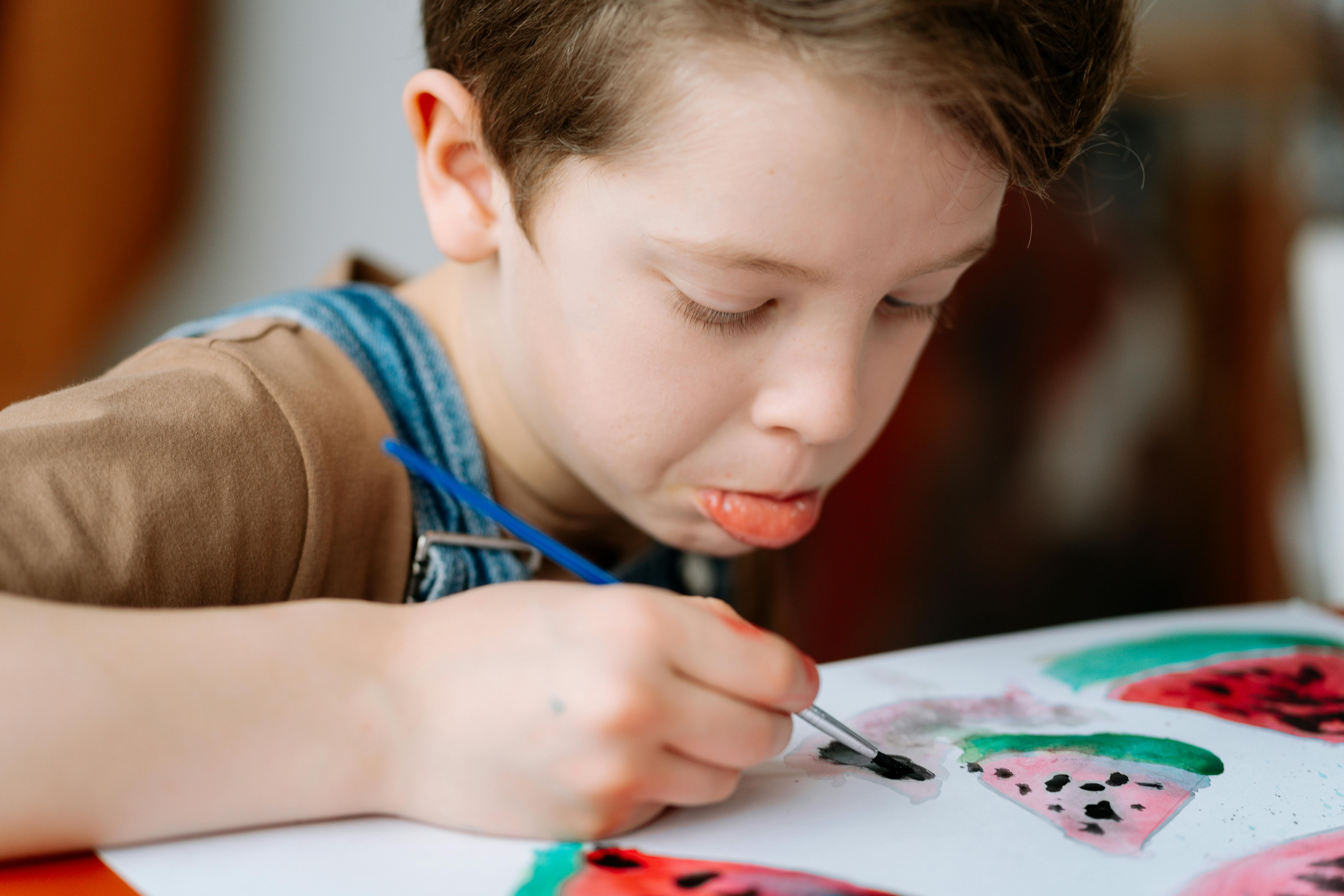
How To Create Art Invitations for Your Child
August 18, 2022
By Beth Herrild
What is an art invitation? An art invitation is basically setting out specific art supplies in an enticing way to encourage kids to engage with them on their own.You probably already know how important art is for your kids’ development. Art invitations are a great way to encourage kids to do more art. The first thing you’ll want to do, if you have the space, is create a designated art area. It doesn’t have to be an entire room. Even a corner will work.
The key is to have art supplies out and accessible for kids. This could be as simple as getting a low bookcase to store things on, putting up a few shelves that are low enough for kids to reach or getting a cart that can be rolled out when kids want to engage. Roll it into the corner when you’re doing something else in that space. Something like this cart works really well.
Have a project table that you don’t mind kids making messes on. This is a great excuse to keep an older table or pick up a used table. Our kitchen table looked like it had been through a war by the time our youngest entered high school! You’ll want to think about protecting your floor also. Some parents put down a drop cloth and leave it there. You could also use a shower curtain or an old rug.

Once you have a space set up, how do you make an invitation for your kids to create art? When my kids were little, we always had art supplies out. Even though all three of them are extremely creative, I learned that just setting out art supplies was never enough to engage them. A very few children, who already view themselves as artists, will start creating on their own when a plethora of art supplies are readily available. Most children will feel overwhelmed and not know what to do if they see a bunch of art supplies. So, it helps to set out gentle suggestions periodically. If you keep things fresh and intriguing, you will spark your child’s curiosity. Even if your child already views himself as an artist, chances are, he could benefit by being exposed to different types of mediums and new ideas.
Rotate supplies: Thoughtfully set out different supplies after they go to bed at night, during nap time, or when they are at school. The rotation might be daily, weekly, or monthly. Think in terms of different mediums and types of art. One week you might encourage collage by setting out scissors, an assortment of intriguing paper images, and a glue stick. It’s important to pick out things that they may find intriguing. If you’re going to layout collage supplies I recommend tearing images out of magazines ahead of time rather than laying out magazines for them to look through. If you lay out the magazines, most kids will get lost in the looking and never get to the collage part.
Another time, you might lay out oil pastels or soft pastels. Think about what your kids can handle at a particular age and maturity. If they are pretty mature and restrained, you could lay out a set of oil pastels, some paper, some cotton swabs and a tiny dish of baby oil or vegetable oil. Then you can demonstrate how to color with the oil pastels and use a cotton swab dipped in baby oil to blend. For other children, laying out a dish of oil might be a really bad idea!
Air dry clay is a wonderful material, but something like Model Magic might be better for younger children. Also note that some air dry clays are really oily and difficult to use. Our favorite is Creative Paper Clay because it is soft and easy to work with. Lay either of them out with a rolling pin, fork, spoon and any other kitchen tools that could make texture and are age appropriate for your child. Be sure to also lay out some zip type baggies or containers with lids for the unused clay to go into right away so it doesn’t unintentionally air dry!
Provide an example: Do one yourself or print out something for kids to look at to spark ideas and give them a little bit of structure so it’s not too overwhelming. There are also a lot of videos on YouTube that show different techniques. For a pastel invitation, you could color a little and blend it and then leave the cotton swab next to your paper. Another fun idea is to tear images of faces out of magazines and encourage your kids to draw on them! Or cut the image in half and glue it onto a plain piece of paper so your child can draw the other side of the face.

Lay out examples, but don’t take over: It is important to show what is possible with the materials, but the quickest way to kill kids’ creativity is being too heavy handed with your instructions. If you are laying out leaves for leaf rubbings, you could do a couple to show the technique, while still emphasizing that there are no wrong answers in art. There is a difference between showing a few applicable techniques to use with specific materials and being too directive about how to create a piece of artwork. Read my blog about Process vs Product. It works really well to approach art from the standpoint of discovering it together, which also takes the pressure off you feeling like you have to be the expert!
Personalize to your children: Lay out supplies that you think will spark their interests. If they are into animals, lay out animal images or feathers. If one child is obsessed with robots, provide pieces to make an assemblage sculpture that is robot like: a square box, miscellaneous screws, bolts, and washers, (whatever you find in your junk drawer that isn’t sharp), aluminum foil and even dry pasta shapes along with glue. If she loves butterflies and all things nature, maybe some images of those things.
Try to make things bright and colorful: Color is a magnet for kids.
Make the supplies touchy-feely: If your kids are tactile, keep that in mind when setting out supplies. Some paint brushes and sponges are really soft and inviting to touch. I don’t like traditional finger paints, but pudding works really well for young children. If they end up eating some, no worries. If You have older children, water soluble oil paints are great for finger painting, but be careful not to use any pigments that contain harmful ingredients, like cobalt, zinc and chromium; search out non-toxic paints. If you’re concerned about knowing which pigments are safe, you could have your kids wear gloves. Air dry clay, as I mentioned above, is awesome art medium for kids who are tactile!
If you subscribe to our Kids’ Art Boxes, you can simply open the box, and lay out the materials, picture book, and instructions to pique your child’s interest. Or better yet, read the book together and discover the project together! If you haven’t read my blog about how to talk to your child about her art, it is worth a read now.
Putting the effort in to set up art invitations for your children will pay off in the long run. You are modeling how to explore new mediums (materials) and ideas and express themselves, which will help them all through their lives. If you’re unsure how to spark your kids’ interest, try some different ideas and see what works. Who knows, maybe you’ll enjoy it as much as they do!

